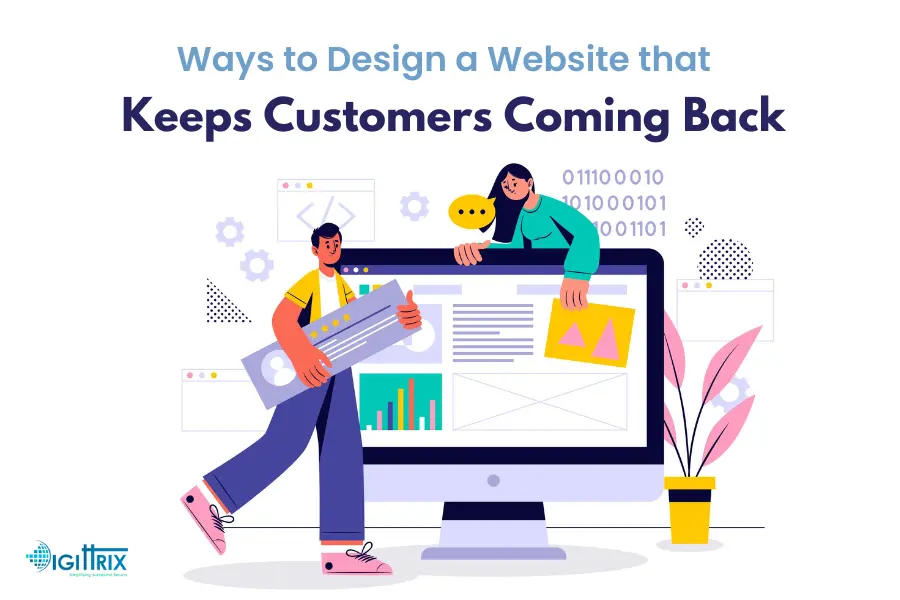
As a business owner, you know that having a website is essential in today's digital world. However, it's not enough to simply have a website - you need a website that engages and retains your customers. A well-designed website can be the difference between a customer coming back or clicking away forever.
In this blog, we will discuss the top ways to design a website that keeps customers coming back. We'll cover everything from the importance of user experience (UX) design to optimizing your website for search engines. Whether you're starting from scratch or revamping an existing site, these tips will help you create a website that will keep your customers coming back for more.
We'll also share real-life examples of websites that have successfully implemented these strategies and have seen impressive results. So, whether you're an e-commerce store, a service provider, or a small business owner, this guide is for you.
In today's competitive digital world, user experience (UX) design is a critical component of website design. A well-designed website with a great user experience can significantly impact the success of your business. A good UX design can help to improve website traffic, increase customer engagement, and ultimately drive more conversions. In this section, we'll cover some essential tips for prioritizing UX design for your website.
To create a great user experience, it's essential to understand your users' needs and expectations. Conducting user research and gathering feedback can help you identify pain points and opportunities for improvement. This feedback can help you make informed decisions about your website design, layout, and content.
Unlock your business's full potential! Discover Digittrix's insights on custom web development and take your business to the next level.
Website navigation is an essential component of UX design. Users should be able to find what they're looking for quickly and easily. A clear and intuitive navigation system can help users navigate your site, find the information they need, and complete desired actions. It's important to organize your content into logical categories and use descriptive labels for navigation menus.
With more than half of all website traffic coming from mobile devices, it's crucial to design your website with mobile users in mind. A responsive website design ensures that your website looks and works well on any device. Optimizing for mobile devices also includes designing for touch screens, simplifying navigation, and minimizing load times.
Also Read, The Benefits of Responsive Web Design For Your Business
Consistency is key when it comes to UX design. Users should be able to recognize your brand and website easily. Consistency in design elements such as colours, fonts, and imagery can help build brand recognition and trust. Make sure to use a consistent design throughout your website, from the homepage to the checkout page.
UX design is an ongoing process of testing and iteration. Conducting user testing and analyzing website analytics can help you identify areas for improvement. Use this feedback to make iterative changes to your website design and continue to improve the user experience over time.
By prioritizing UX design for your website, you can create a user-friendly and engaging experience that keeps customers coming back for more. These tips can help you create a website that not only looks great but also works well and provides value to your customers.
One of the most critical aspects of website design is ensuring that your website is secure and trustworthy for your customers. Customers need to trust your website with their personal and financial information. A secure website is essential in building trust with your customers and can help to prevent potential security breaches. In this section, we'll cover some essential tips for ensuring that your website is secure and trustworthy for your customers.
Secure Sockets Layer (SSL) encryption is an essential security feature that encrypts all data that is transmitted between a website and its users. SSL encryption can help protect your customers' personal and financial information from potential cyber-attacks. Implementing SSL encryption on your website can also boost your website's search engine ranking.
If you're accepting payments on your website, it's essential to use a trusted payment gateway provider. Customers need to trust that their payment information is secure when making a purchase on your website. Using a well-known and reputable payment gateway provider can help build trust with your customers and prevent potential security breaches.
Hackers are constantly looking for vulnerabilities in website software to exploit. Regularly updating your website software, including plugins and themes, can help to prevent security breaches. Software updates often include security patches that address known vulnerabilities. Keeping your website software up to date can help prevent potential security breaches and ensure that your website is secure.
Trust signals, such as security badges, can help to reassure your customers that your website is secure. Displaying trust signals on your website can help to build trust with your customers and improve the perceived security of your website. You can display trust signals such as security badges or industry affiliations on your website to improve customer trust.
Customers want to know how their personal and financial information is being used and protected. Providing a clear and concise privacy policy on your website can help to improve customer trust. Your privacy policy should include information about what data is being collected, how it is being used, and how it is being protected.
Ensuring that your website is secure and trustworthy is essential for building customer trust and preventing potential security breaches. Implementing SSL encryption, using trusted payment gateways, regularly updating your website software, displaying trust signals, and providing a clear privacy policy are essential steps in building trust with your customers.
High-quality, engaging content is essential for keeping customers coming back to your website. Content is not just text; it can also include images, videos, and other multimedia elements. Creating engaging and informative content can help to keep visitors on your site longer, increase user engagement, and improve search engine rankings. In this section, we'll cover some essential tips for creating high-quality, engaging content for your website.
To create high-quality, engaging content, it's essential to understand your audience. Knowing your target audience's interests, needs, and pain points can help you create content that resonates with them. Conducting audience research and analyzing website analytics can help you identify content topics that will be of interest to your target audience.
Valuable content provides your audience with information that is relevant, useful, and engaging. Creating valuable content can help establish your website as a trusted resource for your audience. Valuable content can take many forms, such as how-to guides, industry news, and thought leadership articles.
Using engaging multimedia elements, such as images, videos, and infographics, can help to break up the text and make your content more engaging. Multimedia elements can help to illustrate complex concepts, provide additional context, and keep visitors engaged with your content. Be sure to use high-quality multimedia elements that are relevant to your content.
Search engine optimization (SEO) is essential for getting your content in front of your target audience. Optimizing your content for search engines involves using relevant keywords, optimizing your page titles and meta descriptions, and creating high-quality backlinks. Optimizing your content for search engines can help to improve your website's search engine rankings, making it easier for your target audience to find your content.
Encouraging user engagement is essential for keeping customers coming back to your website. User engagement can take many forms, such as commenting, sharing, and liking. Encouraging user engagement can help to create a community around your website and establish your website as a trusted resource in your industry.
Creating high-quality, engaging content is essential for keeping customers coming back to your website. By understanding your audience, creating valuable content, using engaging multimedia elements, optimizing your content for search engines, and encouraging user engagement, you can create a website that provides value to your audience and keeps them coming back for more.
Optimizing your website for search engines and social media is critical to driving traffic to your website and keeping customers coming back. Search engine optimization (SEO) and social media optimization (SMO) involve optimizing your website's content, structure, and meta information to make it more visible and attractive to search engines and social media platforms. In this section, we'll cover some essential tips for optimizing your website for search engines and social media.
Keyword research is the process of identifying the words and phrases that people use when searching for information online. Conducting keyword research can help you identify the keywords and phrases that are relevant to your content and target audience. This information can help you optimize your content to rank higher in search engine results pages (SERPs).
Creating quality content is essential for optimizing your website for search engines and social media. Quality content is informative, engaging, and relevant to your target audience. Search engines and social media platforms prioritize high-quality content, making it more visible and shareable. Quality content also helps to establish your website as a credible and trustworthy source of information.
On-page optimization involves optimizing the elements on your website, such as page titles, headings, meta descriptions, and URLs, to make them more visible and attractive to search engines and social media platforms. On-page optimization helps search engines and social media platforms understand the content on your website better, making it more likely to rank higher in SERPs and get shared on social media.
Backlinks are links from other websites that point to your website. Building quality backlinks is an essential part of SEO and SMO. Quality backlinks from reputable websites can help to improve your website's visibility and credibility, making it more attractive to search engines and social media platforms. Building quality backlinks requires creating quality content and engaging with other websites in your industry.
Social media is an essential tool for driving traffic to your website and keeping customers coming back. Using social media involves creating and sharing content on social media platforms, engaging with your audience, and building relationships with other businesses and influencers in your industry. Social media can also help to improve your website's visibility and credibility, making it more attractive to search engines and social media platforms.
Optimizing your website for search engines and social media is critical to driving traffic to your website and keeping customers coming back. By conducting keyword research, creating quality content, optimizing on-page elements, building quality backlinks, and using social media, you can create a website that is more visible and attractive to search engines and social media platforms.
Providing excellent customer support and feedback options on your website is crucial for creating a positive customer experience and building customer loyalty. Customer support and feedback options allow customers to get in touch with you if they have questions or concerns and provide valuable insights into their experience with your website. In this section, we'll cover some essential tips for providing excellent customer support and feedback options on your website.
Offering multiple contact channels, such as email, phone, and live chat, can make it easier for customers to get in touch with you. Providing multiple contact options also shows that you value your customers' time and are willing to provide support in the way that is most convenient for them.
Creating a comprehensive FAQ (Frequently Asked Questions) section can help to address common questions and concerns that customers may have. A well-designed FAQ section can save customers time by providing quick answers to their questions and can reduce the volume of support inquiries you receive.
Implementing a ticketing system can help you manage customer inquiries more efficiently. A ticketing system allows you to track and prioritize support requests, ensuring that you can provide timely and effective support to your customers.
Providing feedback options, such as surveys and feedback forms, can help you understand your customers' needs and preferences better. Feedback options can also provide valuable insights into areas where you can improve your website and customer support processes.
Being responsive and proactive is essential for providing excellent customer support. Responding to customer inquiries promptly and proactively reaching out to customers to address their concerns shows that you value their business and are committed to providing a positive customer experience.
Providing excellent customer support and feedback options on your website is essential for creating a positive customer experience and building customer loyalty. By offering multiple contact channels, creating a comprehensive FAQ section, implementing a ticketing system, providing feedback options, and being responsive and proactive, you can create a website that provides exceptional customer support and fosters customer loyalty.
If you're looking to hire a professional designer to help you design a website that keeps your customers coming back, don't hesitate to reach out to us. Our team of experienced web designers can help you create a website that is visually appealing, user-friendly, secure, and optimized for search engines and social media. Contact us today to learn more about our services and how we can help you create a website that meets all the standards and exceeds your customers' expectations.
Design your website with us. We are a leading website design and development company with 14 years of experience and expert developers at DIGITTRIX!
If you too want to build a custom website with an SEO friendly framework and are unsure of how to begin the process, schedule your appointment or book your consultation today with our expert technical managers by calling +91 8727000867
or write to us for all your queries at digittrix@gmail.com


Written by Vandana Abrol
An enthusiastic developer and skilled business management expert with over a decade of experience in the field
Do you need help in ?




Join over 1500+ businesses we've already helped!
Prioritizing UX is important because it creates a positive experience for customers, making them more likely to return to your website.
You can ensure your website is secure and trustworthy by implementing security measures such as SSL encryption, and two-factor authentication, and regularly updating your software and plugins.
High-quality, engaging content such as blog posts, videos, infographics, and social media posts can help to keep customers engaged and interested in your website.
You can optimize your website for search engines and social media by using relevant keywords, creating shareable content, and ensuring your website is mobile-friendly.
Effective ways to provide customer support include offering multiple contact channels, creating a comprehensive FAQ section, and implementing a ticketing system.

©2025Digittrix Infotech Private Limited , All rights reserved.